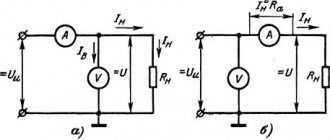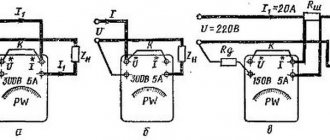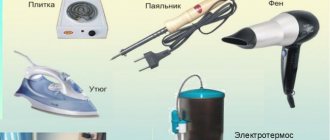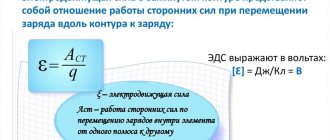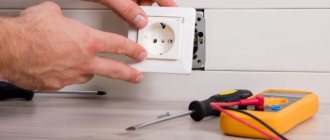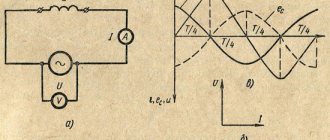A little history
Numerous experiments carried out at the end of the 18th and beginning of the 19th centuries made it possible not only to establish the basic properties and laws of electricity, but also to formulate an epoch-making conclusion about the equivalence between heat and mechanical work: work, or, as they later began to formulate, “energy” , is never lost, but only passes from one type to another. This conclusion, which later received the name of the law of conservation and transformation of energy (see subsection 1.2), was that heat can be converted into mechanical work and vice versa, and that from a certain amount of heat only a certain amount of mechanical work can be obtained. One can cite thousands of examples where, with the help of this law, the results of experiments in various fields of natural science were objectively interpreted.
Joule Lenz's law in brief
Electrical engineers also used the basic principles of the law of conservation of energy to determine, for example, the amount of thermal energy released in a galvanic battery as a result of a chemical reaction and subsequently converted into electrical energy. However, the peculiarity of electrical energy is that electricity itself is not applicable. Humanity cannot use it directly, just as it is warmed by heat, sees through light, etc. You can only use the action of electric current, in which electricity is converted into other forms of energy.
One of the first to deeply study the properties of electric current in 1801–1802 was St. Petersburg academician V.V. Petrov (1761–1834), who conducted many experiments to study the laws of electric current unknown at that time. Having studied the work of his predecessors, Petrov came to the conclusion that a more complete and comprehensive study of electric current is possible only with the help of large galvanic batteries, the action of which will be more intense and easier to observe. For his experiments, Petrov built the largest battery in the world in those years, consisting of 4,200 copper and zinc circles placed in four wooden boxes, and received from it an electromotive force of about 1,700 volts. Thanks to the “lying” design, the heavy metal mugs did not squeeze out the liquid that soaked the paper mugs that separated the zinc and copper elements. To insulate, he coated the inside walls of the drawers with wax varnish. The total length of the battery was 12 m. All this allowed him to build a “huge, especially” battery, which the world had not yet known. Already in 1801, he found the dependence of the current on the cross-section of the conductor, while the German physicist Ohm, who worked on these problems, published the results of his experiments only in 1827. Very soon he noticed that when an electric current passes through a conductor, the latter heats up.
In his works V.V. Petrov describes experiments on the electrolysis of vegetable oils, as a result of which he discovered the high electrical insulating properties of these oils. Later, oils were widely used as electrical insulating materials. Wanting to demonstrate the phenomenon of electrolysis simultaneously in several tubes with water, Petrov was the first to use a parallel connection of electric current receivers. The work of this outstanding scientist established the possibility of practical use of electric current to heat conductors.
Emilius Christianovich Lenz (1804–1865) - a famous Russian physicist and electrical engineer, academician of the St. Petersburg Academy of Sciences, rector of St. Petersburg University - was born in Dorpat (now Tartu, Estonia) in the family of an official. After his second year at the University of Dorpat, he set off in 1823 on a three-year voyage around the world. Using the instruments he designed (a depth meter and a bathometer), he carried out physical research in the waters of the Bering Strait, the Pacific and Indian Oceans, established the origin of warm and cold sea currents, and discovered the law of oceanic circulation. In 1829, he took part in an expedition to the Caucasus, where he carried out magnetic, thermometric and barometric measurements in the mountainous regions of the Caucasus and on the coast of the Caspian Sea. In 1830 he was appointed extraordinary professor and director of the physics office at the St. Petersburg Academy of Sciences, in 1836 he headed the department of physics at St. Petersburg University, and in 1863 he became the rector of this university. His main works are devoted to electromagnetism, questions of the theory and practical application of electricity, research in the field of which Lenz began in 1831 in the laboratory of the first Russian electrical engineer - Academician V.V. Petrova. Lenz stood at the origins of the first school of physicists and electrical engineers in Russia, whose followers were A.S. Popov, F.F. Petrushevsky, V.F. Mitkevich et al.
The dependence of the amount of heat released on the current strength was studied by the English physicist James Joule and the Russian physicist Emilius Lenz. They passed current through a spiral placed in a calorimeter with water. After some time the water warmed up. From its temperature it was easy to calculate the amount of heat released. From experiments carried out almost simultaneously, Joule and Lenz came to the conclusion that when galvanic current I passes through a conductor with a certain resistance R, work A is performed during time t:
It will be interesting➡ Direct current - definition and parameters
A = I 2 Rt,
manifested in the form of released heat.
This important conclusion of the reversibility of electrical and thermal energy, theoretically substantiated by William Thomson, was called the Joule-Lenz law, and the unit of mechanical work in the SI system was named after Joule.
By combining conductors of different resistances connected in series in a common circuit, it is possible to achieve the concentrated release of a large amount of heat in a small section of a conductor with a high resistance. All initial experiments in converting the energy of electric current into thermal and even light energy were based on this concentration of heat release.
The essence of this law
All his life V.V. Petrov, a member of two academies, lived modestly and unnoticed. He worked for 41 years at the Medical-Surgical Academy. During this time, he conducted many physical experiments, wrote three books and a textbook on physics, which was used in gymnasiums throughout Russia. Petrov wrote books and scientific articles in Russian so that as many people as possible could read them, although at that time it was customary to write scientific works in Latin. He wrote: “I hope that enlightened and impartial physicists will at least one day agree to give my works the justice that the importance of these latest experiments deserves.”
About Joule Lenz's law
Let us consider an arbitrary section of a direct current circuit, to the ends of which a voltage U is applied. During a time t, a charge passes through each section of the conductor. This is equivalent to the fact that charge q is transferred in time t from one end of the conductor to the other.
Interesting material: All about Ohm's law
In this case, the forces of the electrostatic field and external forces acting in this area perform work. Dividing the work by the time t during which it is performed, we obtain the power developed by the current in the area under consideration.
Emilius Lenz
This power can be spent on doing work on external bodies; on the occurrence of chemical reactions; to heat a given section of the circuit, etc.
In the case when the conductor is motionless and no chemical transformations take place in it, the work of the current is spent on increasing the internal energy of the conductor, as a result of which the conductor heats up. It is commonly said that when current flows in a conductor, heat is generated
This relationship is called the Joule–Lenz law. It was experimentally established by the English physicist D. P. Joule and confirmed by the precise experiments of E. H. Lenz.
If the current strength changes with time, then the amount of heat released in the conductor during time t is calculated by the formula
From formula (4.1), we can move on to an expression characterizing the release of heat at various points of the conductor. Let us select an elementary volume in the conductor in the form of a cylinder. According to the Joule–Lenz law, during the time dt, an amount of heat will be released in this volume
where dV is the elementary volume. Dividing this expression into dV and dt, we find the amount of heat released per unit volume per unit time:
The quantity is called the specific thermal power of the current. This formula is the differential form of the Joule–Lenz law.
Questions
- What is the physical meaning of the specific thermal power of the current? 2) Write the Joule-Lenz law in integral and differential forms
Work and current power. Joule-Lenz law
- Electric current is so widely used because it carries energy. This energy can be converted into any form.
Work done by current
During the ordered movement of charged particles in a conductor, the electric field does work. This work is usually called current work.
If during a period of time Δt a charge Δq passes through the cross section of an arbitrary section of a conductor, then the electric field will do work during this time (see § 1.19)
where U is the voltage at the ends of the conductor. Since the current strength
then this work is equal to:
The work done by the current in a section of the circuit is equal to the product of the current, the voltage in that section and the time during which the work was done.
According to the law of conservation of energy, this work must be equal to the change in the energy of the section of the circuit under consideration. Therefore, the energy released in a given section of the circuit during the time Δt is equal to the work of the current [see. formula (2.7.1)].
If in formula (2.7.1) we express either voltage in terms of current (U = IR) or current in terms of voltage (I = U/R), we obtain two more formulas for the work of current:
Formula (2.7.1) is universal, since to derive it we used only the law of conservation of energy, which is valid in all cases. Formulas (2.7.2) and (2.7.3) are obtained from formula (2.7.1) using Ohm’s law for homogeneous sections of the chain. Therefore, these formulas are valid only in the case when the work of the current is completely used to increase the internal energy of the conductor.
Formula (2.7.2) is convenient to use when connecting conductors in series, since the current strength in this case is the same in all conductors. Formula (2.7.3) is convenient when connecting conductors in parallel, since the voltage on all conductors is the same.
Current power
Any electrical device (lamp, electric motor, etc.) is designed to consume a certain amount of energy per unit of time. Therefore, along with the work of current, the concept of current power is very important. The current power P is equal to the ratio of the work done by the current A during the time Δt to this time interval:
Using formula (2.7.1), we can give equality (2.7.4) the form:
Formula (2.7.5) is a universal formula for calculating current power. Using Ohm's law, you can obtain two more formulas for current power:
Formulas (2.7.6) and (2.7.7), as well as (2.7.2) and (2.7.3), are suitable only when the work of the current is completely used to increase the internal energy.
The SI unit of work for current is the joule (J) and power is the watt (W). In practice, the off-system unit of current work is widely used - kilowatt-hour (kW • h): 1 kW • h = 3.6 • 10 6 J.
Joule-Lenz law
If no mechanical work is performed on a section of the circuit and the current does not produce chemical effects, then only heating of the conductor occurs. A heated conductor gives off heat to surrounding bodies.
Heating of a metal conductor occurs as follows. An electric field accelerates electrons. After colliding with ions of the crystal lattice, they transfer their energy to the ions. As a result, the energy of the chaotic movement of ions near equilibrium positions increases. This means an increase in internal energy. The temperature of the conductor rises, and it begins to transfer heat to surrounding bodies. A short time after the circuit is closed, the process is established and the temperature stops changing over time. Due to the work of the electric field, energy is continuously supplied to the conductor. But its internal energy remains unchanged, since the conductor transfers to surrounding bodies an amount of heat equal to the work done by the current. The latter is true only when the work of the electric current is completely spent on increasing internal energy. In this case, the amount of heat transferred by the current-carrying conductor to other bodies can be calculated using any of the formulas (2.7.1)—(2.7.3):
However, if in a given section of the circuit there is a transformation of energy into mechanical or chemical energy, then the amount of heat released by the conductor with current is less than the work done by the current*.
To calculate the amount of heat released in this case, only formula (2.7.2) is suitable:
This is the Joule-Lenz law, established experimentally in 1842 by the Russian academician E. H. Lenz and, independently of him, by the English physicist D. Joule.
The Joule-Lenz law is formulated as follows: the amount of heat released by a conductor carrying current is equal to the product of the square of the current strength, the resistance of the conductor and the time it takes for the current to pass.
The Joule-Lenz law (2.7.9) is valid not only for metal conductors, but also for solutions of electrolytes and gases. In these cases, the internal energy of a liquid and gaseous conductive substance also increases due to collisions of orderedly moving charged particles with other charged or neutral particles of the substance.
| The passage of electric current through a conductor is accompanied by the release of energy in it. This energy is determined by the work of the current: the product of the transferred charge and the voltage at the ends of the conductor. |
From the lecture course
When current flows through a conductor with resistance, the conductor heats up (if it is motionless and there are no chemical transformations in it, then the work of the current is spent on heating the conductor). Let us determine the amount of heat released per unit time in a section of the circuit. Let's consider homogeneous and inhomogeneous sections of the circuit, we will use Ohm's law and the law of conservation of energy.
It will be interesting➡ What is a bridge rectifier and how does it work?
Homogeneous chain section
Let's calculate the work that field forces do on current carriers in section 1–2 during time dt. Current strength in conductor I, potential difference between points 1 and 2 – (j1 – j2). Then: – such a charge will flow through the cross section of section 1-2.
the work done when the charge dq is transferred through the cross section of the conductor in section 1–2, by field forces.
According to the law of conservation of energy, energy equivalent to this work is released in the form of heat if the conductor is motionless and no chemical transformations occur in it, i.e. the conductor heats up. Current carriers (electrons in metals) as a result of the work of field forces acquire additional kinetic energy, and then spend it to excite lattice vibrations when colliding with its atom nodes. Then:
Because , having integrated, we get:
but because
This formula expresses the Joule-Lenz law for a homogeneous section of the circuit in integral notation form. If the current strength changes with time, then the amount of heat released during time t is calculated by the formula:
Let us obtain the differential form of writing the Joule-Lenz law.
; ; – the value of the elementary volume.
Formula (24.6) determines the heat released throughout the conductor; we can move on to an expression characterizing the heat release in different places of the conductor. Let us select an elementary volume in the conductor in the form of a cylinder. According to the Joule-Lenz law, heat is released in this volume during the time dt.
Dividing this expression into dV and dt, we find the amount of heat released per unit volume per unit time, this value is called the specific thermal power of the current w.
Specific thermal power of current is the amount of heat released per unit time in a unit volume of a conducting medium.
Then:
That
Formula (24.9) is a differential form of writing the Joule-Lenz law. Let's formulate it:
The specific thermal power of the current is proportional to the square of the electric current density and the resistivity of the medium at a given point.
The equation is applicable to any conductors, regardless of their shape, uniformity and the nature of the forces that excite the electric current. If only electric forces act on current carriers, then, according to Ohm’s law:
That
This equation is less general than the equation
General information
In 1941, the English physicist James Joule and, independently of him, in 1942, the Russian scientist Emilius Lenz, discovered the Joule-Lenz equation. It allows you to calculate using the formula the amount of heat in an electrical circuit released when an electric current passes through a conductor. The amount of heat generated by a conductor when current flows through it depends on the voltage, time, current strength and resistance of the conductor. The discovery made it possible to accurately calculate the circuits of various devices when designing them.
Before formulating the Joule-Lenz law, one should consider and understand the physical meaning of the basic and derivative quantities on which depends how much heat a conductor releases when an electric current passes through it.
Potential difference
It has been scientifically proven that every substance consists of atoms, which also consist of elementary or subatomic particles. These include the following: electrons, protons and neutrons. The atom in the initial state has a neutral charge, since the number of protons and electrons are equal and, therefore, the equality of positive and negative charges is true, and they cancel each other.
However, cases arise when an atom “captures” an electron from another atom. If an atom captures an electron, it is called a negative ion, and when it loses it, it becomes a positive ion. As a result of the loss or attraction of a subatomic negatively charged particle, an electromagnetic field is generated, the component of which depends on the charge of the ion.
The difference between the positive and negative components is the voltage, the unit of which is the volt (symbol: V or V). The greater the difference, the greater the voltage. In some sources it is also called potential difference, the value of which can be measured using a voltmeter or calculated using formulas. When potentials with opposite signs are connected, an electric current is formed, which represents the ordered movement of charged particles and, under the influence of the force of an electromagnetic field, has a vector direction.
In the scientific literature you can find the following definition: electrical voltage is the work that is performed when a point charge moves. Thus, 1 V is the voltage between two point positive and negative charges equal to 1 C, the movement of which requires the energy of an electromagnetic field of 1 J. Auxiliary units of measurement are the following: 1 kV = 1000 V, 1 MV = 10 6 V, 1 mV = 10^(-3), etc.
You might be interested in this: How to make a simple voltage regulator with your own hands
Current strength
Current strength (I) is a value equal to the number of charged particles that pass through a conductor per unit time. The unit of measurement is ampere (A), and an ammeter can be used to measure its value. The device is connected in series with the consumer in an electrical circuit. If an amount of charge equal to 1 C passes through the cross-sectional area of a conductor in 1 second, then this value is a current of 1 A.
The mathematical notation for finding the current strength is: I = Qz / t, where Qz is the charge value, and t is the unit of time. In addition, there are additional units of measurement: 1 mA = 10^(-3) A, 1 kA = 1000 A, etc. Electric current is of the following types:
- Variable.
- Permanent.
Alternating current obeys a certain law, which characterizes the change in amplitude and direction of flow. The main characteristic is the frequency, according to which the division into sinusoidal and non-sinusoidal currents occurs. The graph of a sinusoidal current type is a sinusoid, the formula of which depends on the maximum amplitude Imax and angular frequency w. It has the following form: i = Imax * sin (w * t).
To calculate the angular frequency value, you need the value of the current frequency in the network (f), which is substituted into the formula: w = 6.2832 * f. Direct current does not change the direction of its movement through a conductor, but its value may change.
Electrical resistance
Based on their electrical conductivity, substances can be classified into conductors, semiconductors and dielectrics. The first type includes all substances that conduct current well. This feature is determined by the presence of free charge carriers, information about which can be obtained from the electronic configuration of the elements of D. I. Mendeleev’s periodic system.
Conductors include the following substances: metals, electrolytes and ionized gas. In metals, electrons are charge carriers. In liquids (electrolytes), charge carriers are anions and cations: the former have a positive charge, and the latter have a negative charge. During electrolysis, anions are attracted by the electrode, which is negatively charged (cathode), and cations are affected by the positive charge of the anode. The function of charge carriers in gases is performed by negatively charged electrons and ions.
As the temperature of the conductor increases, atoms interact with each other, as a result of which the crystal lattice is destroyed and free charge carriers appear. When current flows, interaction occurs with the lattice nodes and with the electrons of the conductor, during which the movement of ordered charged particles slows down and thermal energy is released, and then again the speed of their movement returns to its original state, due to the influence of the electromagnetic field. This physical property is called the electrical resistance of a conductor, and when it is heated, its value increases.
You might be interested in Calculation and tables for selecting cable cross-sections based on power and current
Semiconductors are substances that conduct current only under certain conditions. The function of charge carriers is performed by electrons and holes. Under any influence of external energy (for example, thermal), the force of attraction between the nucleus and electrons decreases, during which some of them “break out” and become free, and holes form in their place.
An electromagnetic field of a positive component is formed and a neighboring subatomic particle with a negative charge is attracted to it. This process is repeated and causes the holes to move. The resistance of a substance (conductor or semiconductor) depends on the following factors:
- Temperature indicators.
- Type of substance.
- Lengths.
- Sectional area.
- Current and voltage values.
- Type of current.
Dielectrics are a group of substances that cannot conduct current because they do not contain any electrical charge carriers. Resistance or electrical conductivity is denoted by the letter R and is the interaction of charged particles moving in an orderly manner with the nodes of the crystal lattice. Its unit of measurement is Om.
Power characteristic
Electric current power (P) is the amount of work it does per unit of time. For direct and alternating currents, power is calculated using different ratios. In a direct current circuit, the values of its strength (I) and voltage (U) are equal to instantaneous values. The power formula is written as follows: P = U * I. For a circuit in which Ohm’s law is observed, the formula takes the following form: P = sqr (I) * R = sqr (U) / R.
For a complete circuit, the formula includes the value of the electromotive force (e): P = I * e. If you need to take into account the value of the internal resistance of the power source (Rin), then the formula must be corrected under the condition of absorption (use in an electric motor circuit or when charging a battery) as follows: P = I * e - sqr (I) * Rin = I * (e - (I * Rin)).
If there is a generator or galvanic element in the circuit (condition for the release of electricity), the formula takes the following form: P = I * (e + (I * Rin)). However, this formula cannot be used to calculate AC power because it changes over time. In AC circuits there is the concept of active, reactive and apparent power:
- Active is determined taking into account the root-mean-square values of U and I, as well as the phase shift angle (a): Pa = I * U * cos (a).
- Reactive (Qр): Qp = U * I * sin (a).
- Full (S): S = sqrt (sqr (Pa) + sqr (Qp)).
The value of Qp>0 if there is an inductive load in the circuit, and if there is a capacitive load - Qp<0. The unit of measurement is watt (W). A current of 1 A at a voltage of 1 V has a power of 1 W.
You might be interested in: Purpose, characteristics and operating principle of a varistor

